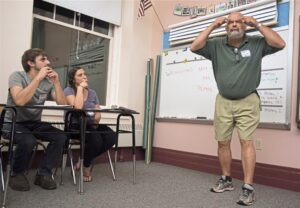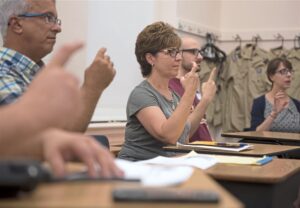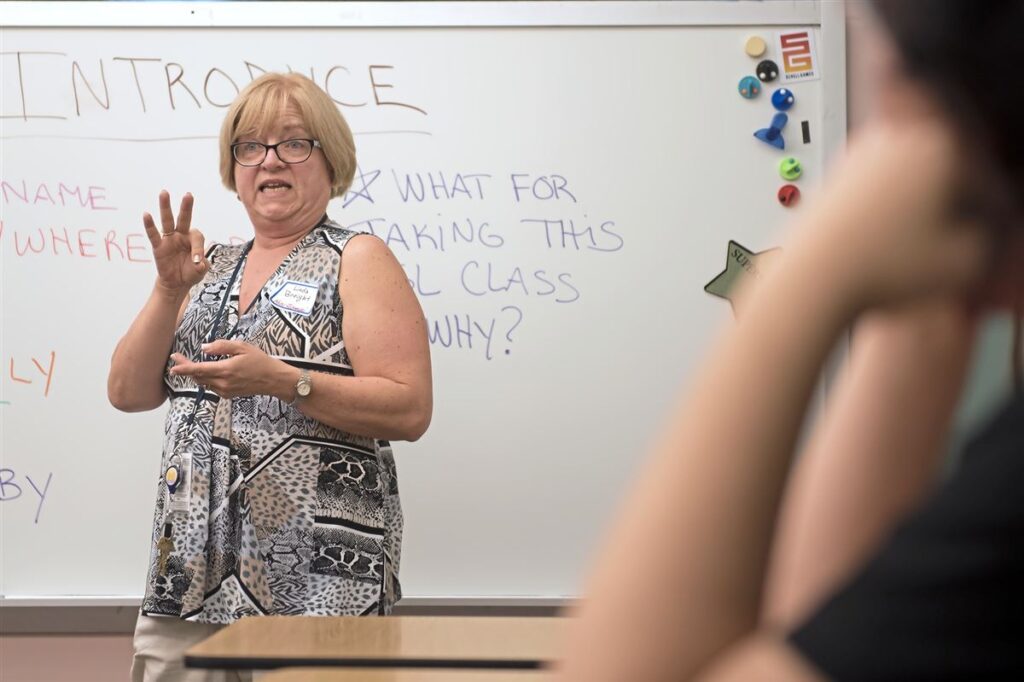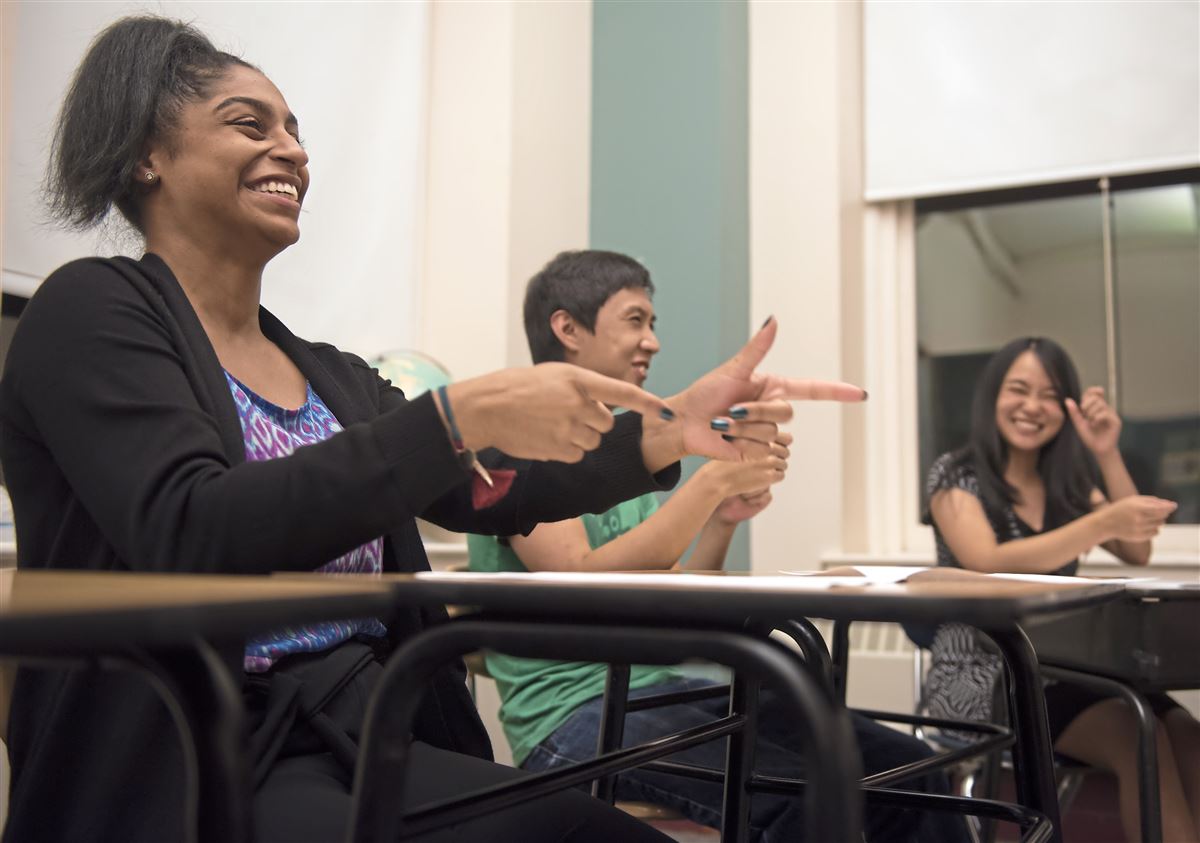When communicating with a person who is deaf or hard of hearing, don’t talk REALLY LOUD because it really won’t help at all. This would seem to be common sense, but it happens all the time, according to deaf people who teach American Sign Language at the Western Pennsylvania School for the Deaf.
It also won’t help to over-enunciate your words. Not all deaf people can read lips because lip-reading is a difficult and inexact art, the instructors said.
To prove their point, they directed a reporter to the “Bad Lip Reading” Facebook page, which has hilarious videos of the “wrong” words coming out of the mouths of professional athletes — and others.
Most, but not all, of the 170 students — from preschool through high school — at the school in Edgewood use American Sign Language.
The nonverbal form of communication uses hands and fingers as well as facial expressions and body language to communicate with people who are deaf or hard of hearing.
On a recent autumn night, 130 adults — none of them deaf — entered the fenced and gated 21-acre campus for evening classes in American Sign Language. Most were signed up for level one classes. Others were in the more advanced classes, levels, two, three and four. They’ll attend eight two-hour classes.
“It is very amazing to me that they have come to learn my language,” said John Noschese. He’s one of the 12 ASL instructors — each of whom is deaf or hard of hearing. He said he is very proud that the fall enrollment of 130 is a sizable increase over the 100 adults who signed up last fall.
American Sign Language is now the third most-popular language taught in the United States, according to the Modern Language Association. Spanish is first, and French is second.

(Haley Nelson/Post-Gazette)
Founded in 1869, the School for the Deaf has been offering ASL to the hearing community for decades, but in recent years, enrollment has been increasing for a variety of reasons.
ASL classes traditionally have been taken by people like Chris Small of Carrick, who wants to communicate with family members who are deaf.
“My father has always been very hard of hearing, and is now about 95 percent deaf,” said Mr. Small, who works with computers.
Others wish to communicate with friends or co-workers, said John Gibson, who supervises the evening ASL classes. Others simply enjoy learning languages.
Some activists push for the language to be taught to more first responders and health care workers.
“I would love to help bridge the gap between ASL and English,” said Mr. Noschese, who graduated from the Western Pennsylvania School for the Deaf and now works in housekeeping there. He’d like to see the language taught in more high schools and colleges.
Mr. Noschese and Mr. Gibson used professional interpreter Joan Stone to answer questions from a reporter and to explain the ASL program to the 130 adults. They sign their answers, and she translates into English.
“This is my favorite part,” said Mr. Gibson, as he pointed to a big screen that read “NO Voicing Policy.” Instead of talking, beginner students could write on a white board if they really needed to, he said.
For their first lesson, instructors invited them to write their names on the white board and taught them how to sign their names.

(Haley Nelson/Post-Gazette)
WPSD instructors and staff also “promote an understanding of Deaf Culture through interaction with deaf and hard of hearing individuals,” according to the website, www.wpsd.org.
Asked how those who hear can help people who cannot, athletic director Val Wojton said, “Just be yourself. Really and truly, deaf people can do everything but hear.”
He also coaches the school’s soccer team, which competes against teams from the hearing community. Mr. Wojton, who was taught to talk, can lip read but he said he has to repeatedly ask referees to talk slower and “look at me” when they talk.
The deaf coach also has to tell referees that he and his players cannot hear the whistle, “so they need to put their arms up in the air when they blow their whistle.”
Mr. Nochese and others noted they can use pen and paper or the screens of cell phones, tablets or laptops to communicate with people who cannot sign, but most prefer more human face-to-face interaction.
Dennita Lewis of New Castle was one of the deaf school students who was helping with the evening classes.
For most of her life, Dennita was mainstreamed in schools where all of the other students could hear, and none of them could sign.
“I had an interpreter. To be honest, it was very hard for me,” she said. When she transferred to the deaf school two years ago, it was culture shock, she said, because “everyone was signing and I knew very little sign language.”
Now a senior, Dennita lives on campus, where she’s happy, proficient in ASL and “I feel like I’m getting a very good education.”
She’s looking forward to going to college and hopes to attend Gallaudet University in Washington, D.C., a federally chartered private school for students who are deaf or hard of hearing.
ASL classes will be offered Wednesday nights at WPSD from Jan. 10 through Feb. 28, and another session will be held March 14 through May 9. Tuition is $60. For information or to sign up for classes: www.wpsd.org.
Linda Wilson Fuoco: lfuoco@post-gazette.com or 412-263-1953.

